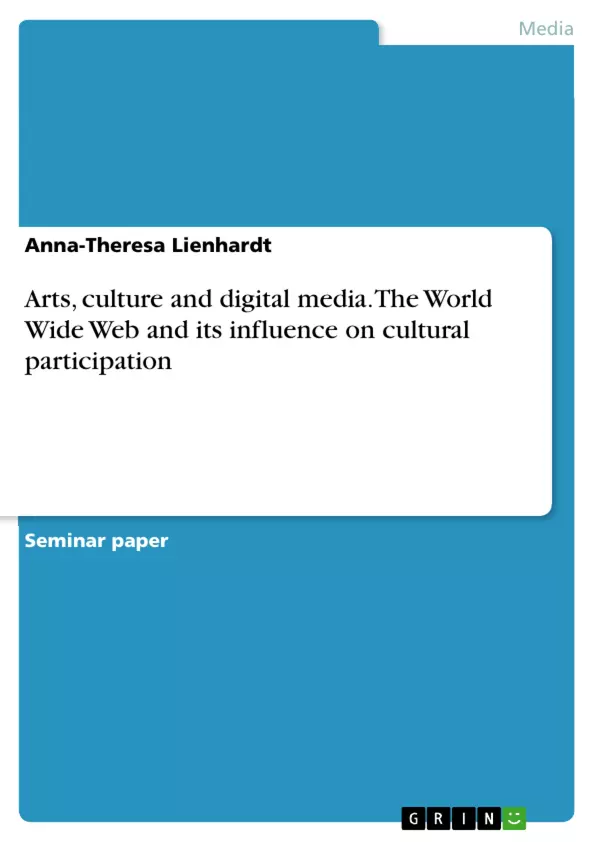The new opportunities humanity gets while society develops and technology grows are seemingly non-terminating. Obviously, many people like to benefit from the arising advantages and the positive side-effects. The World Wide Web is one of these technologies, that on the one hand remarkably facilitate our life and on the other hand lead to a more complex and intertwined system and to changes that can not be reversed.
In times of rapid growing technological progress civilization struggles with the issue of striking new paths to the future while at the same time fostering the own cultural heritage. For some people arts and culture are necessary, because they belong to their roots and are signs of their history, but opinions and notions about that theme vary widely. Still there are hotly debated problems relating to cultural policy – Heilbrun & Gray (2011) argue that arts and culture are caught in a materialistic world (p. 3) which is the reason why they always have to deal with a mighty term called ‘money’. But when thinking about culture and heritage, it is not just about keeping the past in mind and preserving ancient monuments. It is also about actively promoting the arts and culture, that currently come into existence. Technologies arise and so do arts. How to cope now with balancing between past and future, heritage and progress, art and high-tech? Bringing something forward means spending time on it, participating in it and therefore reinforcing it. A modern world needs people who get involved and that is why participation may be one of the pivotal things needed for generating a successful future.
By taking a look at the current situation, I want to examine the special relationship between the use of the internet and participation in arts and culture. What do we understand by thinking of the term ‘cultural participation’ and for which reasons is it so important to participate? Which tool does the internet provide to influence and increase cultural participation and which examples can be made for that? After a general overview, the demand position will be adapted on the concrete example of the Netherlands.
The results may create the basis for developing future scenarios and investigating questions like whether the web's popularity is able to create more popularity for cultural participation or if just the internet's degree of esteem will grow further without any impacts on culture.
Table of Contents
- Introduction: Between cultural heritage and technological advance
- Cultural participation: a definition
- The internet and its influence on cultural participation
- Information: Supporting ‘traditional forms' of participation in arts and culture
- Creation: Supporting ‘digital forms' of participation in arts and culture
- Status Quo in the Netherlands
- Conclusion
- References
Objectives and Key Themes
This essay explores the relationship between the internet and cultural participation. It aims to define cultural participation, analyze the role of the internet in influencing it, and examine specific examples of this influence, particularly in the Netherlands. It seeks to understand how the internet may impact cultural participation and its future development.
- The definition and significance of cultural participation
- The role of the internet in facilitating cultural participation
- The impact of the internet on both traditional and digital forms of cultural engagement
- The current state of cultural participation in the Netherlands
- The potential future of cultural participation in a digital age
Chapter Summaries
- Introduction: Between cultural heritage and technological advance: This chapter introduces the concept of cultural participation and its importance in a rapidly developing world, highlighting the tension between preserving cultural heritage and embracing technological advancements. It explores the challenges of balancing past and future in the context of arts and culture.
- Cultural participation: a definition: This chapter provides a comprehensive definition of cultural participation, drawing on international frameworks and highlighting its recognition as a human right. It discusses various interpretations of the term, exploring the different dimensions and categories of cultural participation.
- The internet and its influence on cultural participation: This chapter explores the growing influence of the internet and new technologies on cultural participation. It discusses how these technologies can facilitate communication, overcome geographical barriers, and foster new forms of artistic expression and cultural exchange.
Keywords
The primary focus of this essay lies in understanding the relationship between the internet and cultural participation. Key themes include cultural heritage, technological advancements, cultural participation as a human right, the impact of the internet on cultural engagement, information and communication technologies (ICT), and the status quo of cultural participation in the Netherlands. The essay further explores the potential future scenarios of cultural participation in a digital age.
- Quote paper
- Bachelor of Arts Anna-Theresa Lienhardt (Author), 2013, Arts, culture and digital media. The World Wide Web and its influence on cultural participation, Munich, GRIN Verlag, https://www.hausarbeiten.de/document/279981


